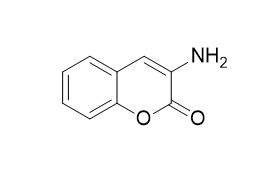3-Aminocoumarin
3-Aminocoumarin is a new ligand for synthesis of potentially biologically active complexes of the platinum metals.
Inquire / Order:
manager@chemfaces.com
Technical Inquiries:
service@chemfaces.com
Tel:
+86-27-84237783
Fax:
+86-27-84254680
Address:
1 Building, No. 83, CheCheng Rd., Wuhan Economic and Technological Development Zone, Wuhan, Hubei 430056, PRC
Providing storage is as stated on the product vial and the vial is kept tightly sealed, the product can be stored for up to
24 months(2-8C).
Wherever possible, you should prepare and use solutions on the same day. However, if you need to make up stock solutions in advance, we recommend that you store the solution as aliquots in tightly sealed vials at -20C. Generally, these will be useable for up to two weeks. Before use, and prior to opening the vial we recommend that you allow your product to equilibrate to room temperature for at least 1 hour.
Need more advice on solubility, usage and handling? Please email to: service@chemfaces.com
The packaging of the product may have turned upside down during transportation, resulting in the natural compounds adhering to the neck or cap of the vial. take the vial out of its packaging and gently shake to let the compounds fall to the bottom of the vial. for liquid products, centrifuge at 200-500 RPM to gather the liquid at the bottom of the vial. try to avoid loss or contamination during handling.
J Cell Mol Med.2020, 24(21):12308-12317.
Food Chem.2024, 456:140044.
Tissue Cell.2022, 78:101901.
Biosci Rep.2020, 40(8):BSR20201219.
Front Pharmacol.2021, 12:761922.
Int J Mol Sci.2022, 23(5):2796.
Pharmaceuticals (Basel).2024, 17(8):1001.
Industrial Crops and Products2020, 146:112186
J Applied Biological Chemistry2021, 64(2):185-192
TCI CO.2019, US20190151257A1
Related and Featured Products
Molecules, 2011, 16(8):6969-6984.
Antimicrobial and antioxidant activities of new metal complexes derived from 3-aminocoumarin.[Pubmed:
21844844]
3-Aminocoumarin (L) has been synthesized and used as a ligand for the formation of Cr(III), Ni(II), and Cu(II) complexes.
METHODS AND RESULTS:
The chemical structures were characterized using different spectroscopic methods. The elemental analyses revealed that the complexes where M=Ni(II) and Cu(II) have the general formulae [ML(2)Cl(2)], while the Cr(III) complex has the formula [CrL(2)Cl(2)]Cl. The molar conductance data reveal that all the metal chelates, except the Cr(III) one, are non-electrolytes. From the magnetic and UV-Visible spectra, it is found that these complexes have octahedral structures. The stability for the prepared complexes was studied theoretically using Density Function Theory. The total energy for the complexes was calculated and it was shown that the copper complex is the most stable one. Complexes were tested against selected types of microbial organisms and showed significant activities.
CONCLUSIONS:
The free radical scavenging activity of metal complexes have been determined by measuring their interaction with the stable free radical DPPH and all the compounds have shown encouraging antioxidant activities.
Bulletin of the Academy of ences of the Ussr Division of Chemical ence, 1980, 29(11):1712-1715.
3-Aminocoumarin: A new ligand for synthesis of potentially biologically active complexes of the platinum metals.[Reference:
WebLink]
METHODS AND RESULTS:
1. The complex compounds of platinum(II) and palladium(II) with 3-Aminocoumarin, with the composition M·(3-Aminocoumarin)2X2, where M=Pt, Pd, X=Cl, Br, I, have been synthesized for the first time. 2. These complexes have the cis configuration; the ligand is coordinated with the metal via the nitrogen atom of the amino group.



